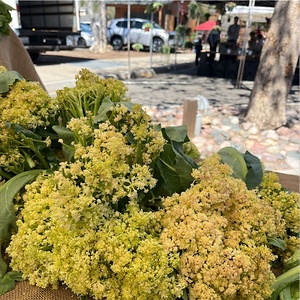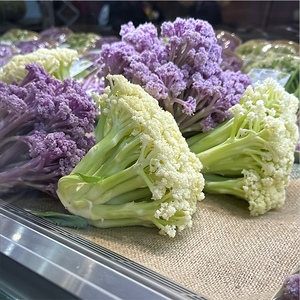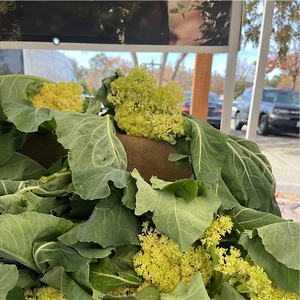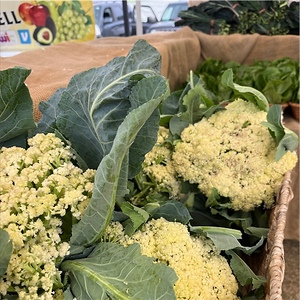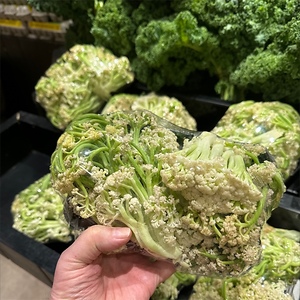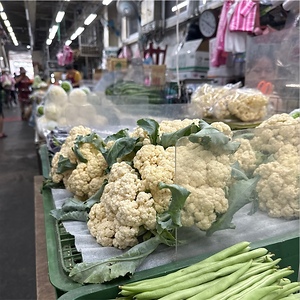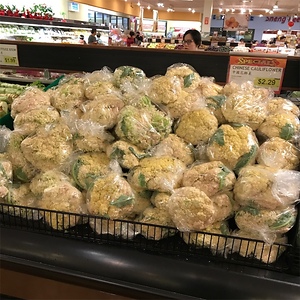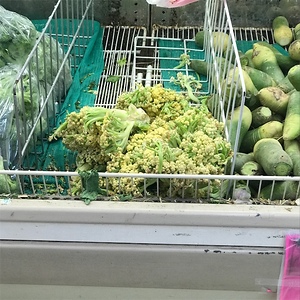

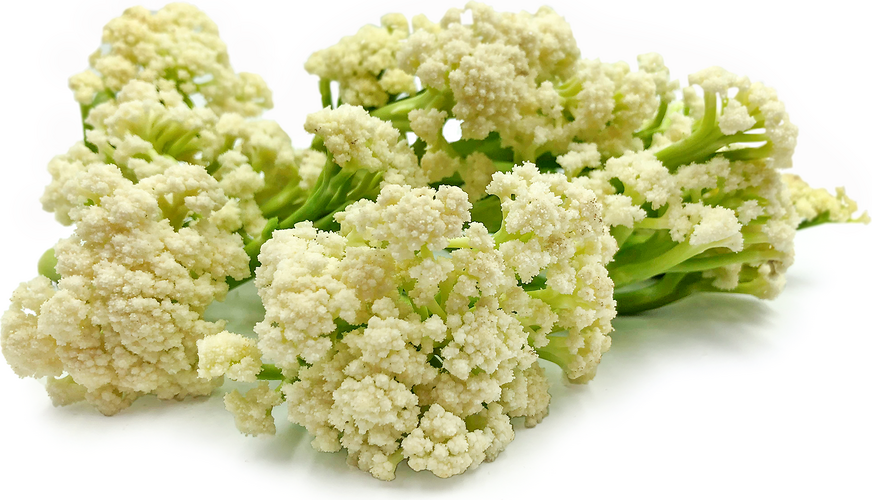
Fioretto Cauliflower
Estimated Inventory, lb : 0
Description/Taste
Fioretto is comprised of a loose head made up of branching, slender stocks with tiny, clustered buds. The elongated stems are smooth, firm, taut, and pale green, typically harvested when they reach 15 to 20 centimeters in length. Fioretto has characteristically longer and thinner stems, allowing the heads to be easily separated into smaller pieces. The stems connect to groupings of tiny, white, unopened buds, also known as florets, and these buds are pliable and lightly textured. Fioretto is more delicate than common cauliflower, and the stems have a succulent, crisp, and chewy consistency when raw. Fioretto is also said to have a higher Brix level than common cauliflower cultivars, resulting in a sweeter taste. Once cooked, the heads develop a tender texture and retain a pleasing crunch level. Fioretto has a sweet, nutty, and mild flavor, and the sweet nuances become more pronounced once heated.
Seasons/Availability
Fioretto is available year-round, with varying harvest dates from spring, summer, and autumn, depending on the specific variety.
Current Facts
Fioretto, botanically classified as Brassica oleracea var. botrytis, is a specialty hybrid belonging to the Brassicaceae family. The variety was developed by the Tokita Seed Company in Japan and was released through the Oishii Nippon Project in the early 21st century as an easy-to-grow, innovative culinary crop. Fioretto was created through natural breeding methods to showcase elongated, slender stems, making the heads easy to harvest and removable with one cut. Most cauliflower cultivars require trimming and cutting into smaller pieces before incorporating into culinary preparations. Fioretto arose from Mr. Tokita's passion for creating a new cauliflower that naturally grew into smaller pieces for easier preparation. The hybrid plant features a sweeter taste, a crunchy texture, and is entirely edible, reducing waste. Fioretto is an F1 hybrid sold in five different types with varying harvest dates, ranging from Fioretto 60, 70, 75, 80, to 85. Fioretto 60 has the shortest time, meaning the heads can be harvested in 60 to 65 days after planting, and Fioretto 85 is the longest, where the heads are ready in 85 to 90 days. Growers often sow several of these varieties to produce successive plantings, creating a steady harvest over a longer period. Since its release, Fioretto has been appreciated by consumers and chefs for its easy-to-prepare nature and ability to be served raw or cooked in a wide array of sweet or savory preparations.
Nutritional Value
Fioretto has not been extensively studied for its nutritional properties. It is believed to be a source of vitamin C to strengthen the immune system, fiber to regulate the digestive tract, vitamin K to assist in faster wound healing, and potassium to balance fluid levels within the body.
Applications
Fioretto has a mild and sweet taste suited for raw and cooked preparations. The variety’s thin, crunchy stems can be tossed into salads or served fresh on crudité plates as their elongated nature allows them to be dipped in spreads and sauces. Fioretto can also be added to slaws, pickled in vinegar as a condiment, or wrapped in meats as a savory dish. In addition to serving the heads raw, Fioretto turns a pleasant shade of green when cooked and retains its tender, crunchy texture. Fioretto can be sauteed or stir-fried and served as a simple side, steamed and then baked with parmesan, roasted or grilled to develop tenderness and flavor, or battered and fried as a variation of tempura. Try boiling small portions in the microwave or adding them to pasta dishes as an easy meal. They can also be tossed into soups, curries, and stews. Fioretto pairs well with cheeses such as feta, parmesan, and mozzarella, lemon juice, red bell peppers, snow peas, mushrooms, asparagus, corn, carrots, pork belly, bacon, seafood, tofu, and sesame. Whole, unwashed Fioretto will keep up to six days when stored in a plastic bag in the refrigerator’s crisper drawer.
Ethnic/Cultural Info
Fioretto is known by several names worldwide. The most common name, Fioretto, was derived from Italian and roughly translates to mean “little flowers” or “flowerets.” The hybrid variety was given this name as the heads have elongated stems and delicate tops, resembling a bunch of tiny flowers. Fioretto is also known as Karifurore in Japan, White broccoli, Stick cauliflower, Sweet Sprouting cauliflower, Biancoli, Flowering cauliflower, Cauliflore, and Caulini. Stick cauliflower is a name taken from the head’s long stems once it has been broken or sliced apart. In the United Kingdom, the variety was notably branded as “Artisan Biancoli Spears” in Marks & Spencer’s stores to attract consumer attention. It is important to note that Tokita Seed officially sells the variety’s seeds under the name Fioretto, but growers, retailers, and marketing teams may change the cultivar’s name once the heads are grown and packaged for commercial sale to increase consumer appeal.
Geography/History
Fioretto is native to Japan and was developed by the Tokita Seed Company in the Saitama Prefecture. Tokita is a seed company founded in 1917 by Mr. Taisuke Tokita and has been producing quality varieties for over 100 years. It took over seven years to naturally develop Fioretto and the hybrid variety was officially released to the public in 2013. Fioretto is promoted through Oishii Nippon, a branch of the Tokita Seed Company. Oishii Nippon, also referred to as the Oishii Nippon Project, was established in 2018 to introduce high-quality Japanese vegetables developed through Tokita to communities worldwide. Oishii translates from Japanese to mean “delicious,” and Nippon means “Japan.” Seeds promoted through Oishii Nippon are meant to reflect the company’s passion for seasonal vegetables with increased aesthetics, flavors, quality, and cultivation characteristics. Later, in 2015, the Fioretto line was expanded with cold-resistant varieties and cultivars with varying harvest dates for extended planting opportunities. Today, Fioretto is grown and sold worldwide, and it is offered as a delicacy through farmer’s markets, select retailers, and distributors. The hybrid variety is sold whole or pre-packaged in ready-to-cook bundles and is also listed on online seed catalogs for home garden cultivation.
Recipe Ideas
Recipes that include Fioretto Cauliflower. One
Podcasts



